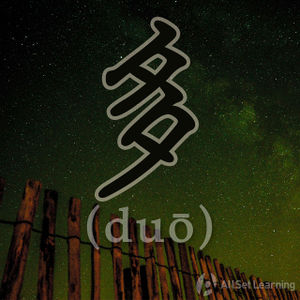Difference between revisions of "Doing something more with "duo""
m (Text replacement - "huí jiā" to "huíjiā") |
|||
| Line 36: | Line 36: | ||
<ul> | <ul> | ||
<li class="q">吃 <em>多</em> 点。<span class="pinyin">Chī <em>duō</em> diǎn.</span></li> | <li class="q">吃 <em>多</em> 点。<span class="pinyin">Chī <em>duō</em> diǎn.</span></li> | ||
| − | <li class="q"> 我 要 回家<em>多</em>点!<span class="pinyin">Wǒ yào | + | <li class="q"> 我 要 回家<em>多</em>点!<span class="pinyin">Wǒ yào huíjiā <em>duō</em> diǎn!</span></li> |
<li class="q">我 应该 运动 <em>多</em> 点。<span class="pinyin">Wǒ yīnggāi yùndòng <em>duō</em> diǎn.</span></li> | <li class="q">我 应该 运动 <em>多</em> 点。<span class="pinyin">Wǒ yīnggāi yùndòng <em>duō</em> diǎn.</span></li> | ||
</ul> | </ul> | ||
Revision as of 07:15, 14 February 2017
-
Level
-
Similar to
-
Used for
-
Keywords
In China, you often hear you should do this or that more (eat more, drink more water, wear more warm clothing etc.), and they often use the word 多 (duō). What's not intuitive to learners is that the word 多 should come before the verb.
Contents
Structure
This structure is often used in commands or suggestions. Note the position of 多:
多 + Verb + Obj.
This structure is not used exclusively as a command, so you could also include a subject if you needed to.
Examples
In English we like to say things like "eat more" and "drink more beer" and "I need to exercise more." Notice that in every one of these cases, the word "more" (equivalent to this use of 多) comes after the verb in English. In Chinese, it's more natural to put the 多 before the verb.
- 多 吃 点。Eat a little more.
- 多 喝 热水。Drink more hot water.
- 多 喝 啤酒 吧!Drink some more beer!
- 我 应该 多 运动。I should exercise more.
Counter-Examples
Just to be completely clear, the following uses of 多 are not as natural as the ones above. They'll be understood, and they might not be technically wrong, but you can do better!
- 吃 多 点。
- 我 要 回家多点!
- 我 应该 运动 多 点。
The opposite of 多 is, of course, 少. It is further explained in the article doing something less with "shao".
See also
Sources and further reading
Books
- Integrated Chinese: Level 1, Part 2 (3rd ed) (pp. 39) →buy
- 发展汉语 中级汉语口语上 (pp. 72)



